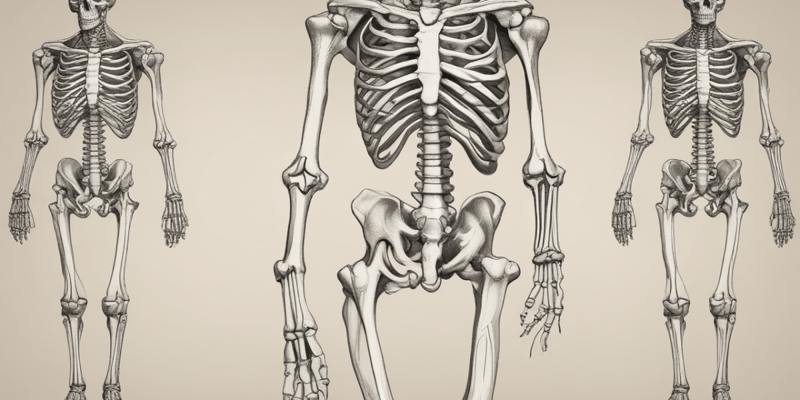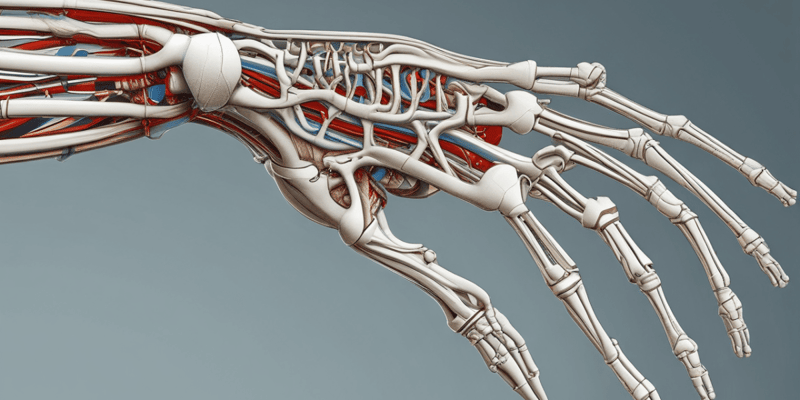24 Questions
How many bones are there in the upper limb?
64
What is the function of the pectoral girdle?
To connect the free upper limb bones to the trunk
How is the scapula attached to the rib cage?
By muscles
What is the shape of the clavicle?
A horizontal letter 'S'
What is the function of the clavicle?
To connect the upper extremity to the trunk
What is the function of the acromial facet on the clavicle?
To articulate with the scapula
What is the function of the trapezoid tubercle on the clavicle?
To attach the coracoclavicular ligament
What is the feature of the medial third of the clavicle?
An impression for costoclavicular ligament
Which of the following borders of the scapula is the strongest and thickest?
Lateral border
What is the purpose of the superior transverse scapular ligament?
To convert the suprascapular notch into a hole
Which of the following structures attaches to the supraglenoid tubercle?
Long head of the biceps brachii muscle
What is the primary function of the subclavius muscle during clavicle fractures?
To provide cushioning and protect surrounding structures
What is the name of the joint formed by the glenoid cavity and the head of the humerus?
Glenohumeral joint
What is the most common type of injury associated with clavicle fractures?
Injuries to the surrounding soft tissues
What is the primary location of the scapula in the body?
At the back of the body
Which of the following angles is formed by the junction of the superior and lateral borders?
Lateral angle
What is the function of the acromion?
To articulate with the clavicle
What is the name of the protrusion on the posterior surface of the scapula?
Spine of scapula
What is the common complication of clavicle fractures?
Brachial plexus injuries
What is the name of the structure that projects anterolaterally from the lateral end of the scapula?
Coracoid process
What is the number of faces, edges, and angles of the scapula?
2 faces, 3 edges, 3 angles
Which of the following structures is formed by the junction of the medial and lateral borders?
Inferior angle
Which muscles attach to the spine of the scapula?
Deltoid and trapezius muscles
What is the most common location of clavicle fractures?
The middle section of the clavicle
Study Notes
Bones of Upper Limb
- The upper limb consists of 64 bones, divided into two parts: the bones of the pectoral girdle and the bones of the free upper limb.
- The pectoral girdle is composed of the clavicle and scapula, which connect the free upper limb bones to the trunk.
Clavicle
- The clavicle is approximately 15-17 cm long and 2-3 cm wide, and has the shape of a horizontal letter "S" on the front of the shoulder and thorax.
- It articulates with the sternum on the inside and the scapula on the outside, connecting the upper extremity to the trunk.
- The clavicle has superior and inferior surfaces, anterior and posterior borders, and sternal and acromial ends.
- The acromial end features a small oval acromial facet for articulation with the scapula.
- The inferior surface of the lateral third of the clavicle has a prominent conoid tubercle and a trapezoid tubercle (line), serving as attachment sites for the coracoclavicular ligament.
- The inferior surface of the medial third of the clavicle has an impression for the costoclavicular ligament.
- Clavicle fractures are common, especially in individuals with less fat in that area, and can result from falls onto the shoulder, direct trauma, or an outstretched arm.
Scapula
- The scapula is a flat, triangular bone located at the 2nd to 7th levels of the ribs, connecting the clavicle to the humerus.
- It has two faces: the costal surface (anterior) and the posterior surface, and three borders: the superior, medial, and lateral borders.
- The scapula has three angles: the superior, inferior, and lateral angles.
- The posterior surface of the scapula is convex and features a protrusion called the spine of scapula, which divides into two concave surfaces: the supraspinous fossa and the infraspinous fossa.
- The deltoid and trapezius muscles attach to the spine of the scapula.
- The superior border of the scapula is the shortest and thinnest, displaying a slight concave shape, and includes a suprascapular notch.
- The lateral border of the scapula is strong and thick, situated closest to the axilla.
- The medial border is the long, medial edge of the scapula closest to the vertebral column.
- The superior angle is formed by the junction of the superior and medial borders, while the inferior angle is formed by the junction of the medial and lateral borders.
- The lateral angle is formed by the junction of the superior and lateral borders and contains the head and neck of scapula.
- The glenoid cavity is a shallow pit on the lateral margin of the scapula's head, forming the glenohumeral joint with the head of the humerus.
- The supraglenoid tubercle is a small ridge above the glenoid cavity, where the long head of the biceps brachii muscle attaches.
- The infraglenoid tubercle is a roughened area below the glenoid cavity, where the long head of the triceps brachii muscle attaches.
- The acromion is the broad, straight lateral extension of the spine of scapula, articulating with the clavicle at the acromioclavicular joint.
- The coracoid process is a thick, beak-like structure that projects anterolaterally from the lateral end of the scapula.
This quiz covers the bones of the upper limb, including the pectoral girdle and free upper limb bones, and their connections to the trunk and rib cage.
Make Your Own Quizzes and Flashcards
Convert your notes into interactive study material.
Get started for free



